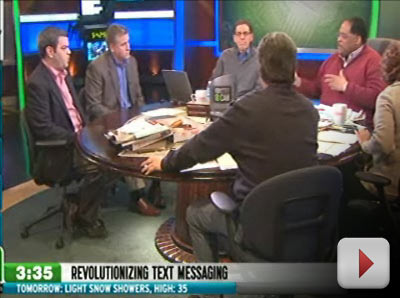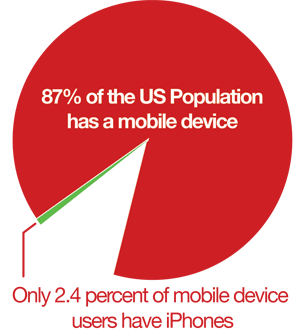Category Archives: Educational
July 12, 2010 by Jessica Zorawski
It’s a common practice for folks to take their mobile phone along anytime they go shopping. A recent study conducted by InsightExpress reports that 4 out of 5 people reported using their mobile phone during shopping trips. However, who are these “people”? And what exactly is meant by “using their mobile phone while shopping”? (Many of us might be imagining a man in the milk aisle, calling his wife to ask whether she prefers 2% or skim.)
The truth is, that stereotype no longer exists. Men ages 25-34 are now looking at their phone to browse coupons that have been sent to them, and they’re doing this more than any other group of consumers. Here are percentages of men, compared to the general population, that used a mobile coupon last month, by location:
- Electronics store – 30 percent (general population 10 percent)
- Clothing store – 33 percent (general population 15 percent)
- Department store – 30 percent (general population 15 percent)
- Service location – 16 percent (general population 7 percent)

According to a recent article by Dan Butcher titled “Who is today’s mobile shopper – and why it’s not her”,10 percent of consumers made a special trip to the store after receiving a mobile coupon and for 18-34 year olds, the figure jumps to 20 percent. Since a younger generation’s actions typically predict future trends, this is likely an indicator that the acceptance of mobile coupons by the general population has already begun.
These figures show the evolution of consumer buying behavior, something that marketers need to understand in order to properly communicate with their audience.
Even in a world of constantly changing consumer behavior, a few things do remain consistent: people are always looking for a deal and shopping is still a social function. So how can you tie the knowledge of these constants into your mobile coupons?
Providing your customers with mobile coupons makes finding a bargain even easier, a conveniance they’re sure to appreciate. The social aspect of shopping may mean your customer is shopping with a group with whom they might share your coupon, stretching your brand’s reach far beyond your customer base.
The bottom line is this: if you want to convince your customers it’s time to check out your latest offerings, especially males and the younger population, send them a mobile coupon.
March 31, 2010 by Molly Anderson
We’re firm believers in text message marketing campaigns and the numerous advantages of using texts over downloadable apps in the marketing world. A recent Adweek article urges businesses choosing between the two to stick with the undeniable reach and results that come with text messaging.
Why is texting superior you ask? Well, it has a lot to do with reach and usage. Juniper Research predicts that smartphones will account for only 23 percent of all new handsets sold per year by 2013. In comparison, nearly every cell phone in the U.S. is able to receive and send text messages. In addition, texting is an every day form of communication, so marketing with texts means reaching clients via their chosen medium. Texting allows businesses to contact customers immediately, wherever they are. What’s more, it doesn’t require customers to locate and download the latest app for information.
An October 2009 report from Strategy Analytics showed that only four to six mobile apps are typically used on an a consistent basis. Constantly competing with the most exciting and buzz-worthy apps available, brands lose out when older apps go unused or hit the recycle bin. In contrast, text messages are simple and reside within the prime real estate of the message list, among our daily conversations.
While there is definitely a time and place for apps, consumer contact and dialogue is maintained with text message marketing. It’s Opt It’s opinion that engaging customers for the long haul is the best way to generate return on investment.
February 19, 2010 by Molly Anderson
Co-founders Brian Stafford and Michael Lamb were guests on Chicago’s CBS 2 morning news show, “Monsters & Money” on February 19. The interview focused on how Opt It, Inc. is revolutionizing the way companies get the word out to consumers via text messaging.
Video is no longer available online.

July 14, 2009 by Molly Anderson
No one can deny the popularity of the iPhone. Everyone’s had the experience of being at a gathering or party recently when a friend or co-worker has pulled out their iPhone just to demonstrate new functionality or the latest downloaded app. Its user-friendliness and sleek, sexy look are second-to-none. iPhone apps even have their own distribution channel built in, adding to a top-notch user experience. This next generation device is certainly an industry leader that is ahead of its time. But at Opt It, we’re concerned that the iPhone might not be the most effective venue for your mobile marketing campaign. Here’s why:

Currently in the U.S., 87 percent of the population has some sort of mobile device. Of that percentage, only 2.4 percent own an iPhone, limiting the reach of any business looking to establish a mobile marketing campaign. In terms of text message marketing campaigns specifically, texting can reach a whopping 98 percent of cell phone users, making it a very powerful marketing tool. When it comes to getting your important message to the largest audience, text messaging is the most successful tool available.
iPhone Applications Advantages
- Next generation device securing its place as an industry leader.
- Slick user interface design allowing for ease-of-use.
- iPhone features allow applications to have a very unique user experience.
- Apple has deployed a built in distribution channel for iPhone applications.
Text message marketing advantages
- Text messages can reach 98% of cell phones in the U.S., which is 88% of the total U.S. population – only 2.4% of U.S. mobile phone users have an iPhone.
- Text messaging is enabled on all phones bought today – no applications to download.
- It is supported on all carriers – iPhone is only supported on AT&T (12% of AT&T subscribers have an iPhone).
- Deployments on shared short codes can be immediate – no waiting for an application to get approved and loaded into the distribution channel.
Here’s the bottom line: when it comes to user experience and next generation devices, we here at Opt It love the iPhone. But for businesses looking to launch a mobile marketing campaign, text messaging is the most effective and immediate way to reach your audience, hands down.
by Molly Anderson
When planning for the launch of your mobile marketing surge, the question of whether to use a shared or dedicated short code for your business is bound to come up. Your short code, the significantly shorter telephone number you’ll obtain and give to customers to use to address SMS messages from their mobile phones, is an important piece of the mobile marketing picture. Consider the following when selecting the code type that makes most sense for your business. If you are unfamiliar with short codes or keywords, please read this short piece describing SHORT CODES and KEYWORDS.
Shared short codes are used across multiple businesses and campaigns. Keyword(s) are assigned to specific clients for executing mobile marketing campaigns. Dedicated short codes are leased and assigned to one business or entity. The business has full control of creating campaigns and keywords and all traffic is routed to that individual client. Dedicated short codes allow you to lease a short code that matches your brand.
As you might imagine, shared and dedicated codes are very different from each other and deciding between them requires careful thought. Take look at how the two types compare on key points of interest:
Cost
Shared codes are more cost effective; they allow you to share the costs of the short code leasing, carrier connectivity and software to run campaigns. Messaging itself is still charged on a usage basis. Dedicated codes are more expensive; businesses pay for total control of all message flows and branding. Total cost for dedicated codes include the short code lease ($500 to $1000 per month), carrier connectivity, campaign software and messaging costs.
Availability of Keyword
Keywords must be unique per shared code. If multiple businesses want the same code, only one will actually receive it. Dedicated codes come with the ability to have unlimited keywords on short codes and full control of how they act.
Branding
Since many companies with shared code will use a code that belongs to others, businesses run the risk of being associated to other brands that advertise more. This is completely averted with dedicated code, where a business is the sole owner of the code. With that total control, dedicated code owners are able to brand their mobile number into customers’ minds just like the service or product they’re selling.
Time
While a shared code can be up and running with minimal wait time, typically in a day, a dedicated code takes much longer, 8 to 12 weeks or more.
If you’re on the fence regarding shared or dedicated code, think about your business goals. Is time of the essence? If so, businesses who want to enter the text messaging arena quickly and with minimal cost will likely move forward with a shared code. Those businesses keen on building their brand are typically happier waiting for a dedicated code as well as incurring the higher associated fees.
Older Posts Newer Posts


